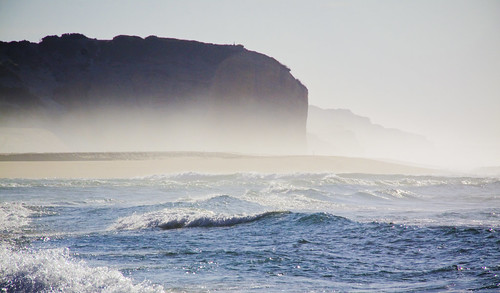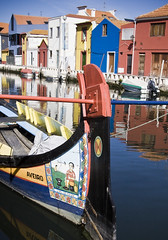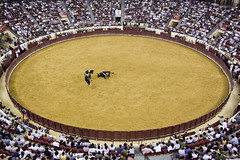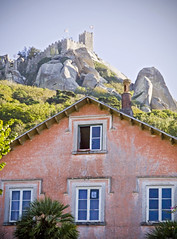Sign up here and receive email alerts when this blog is updated.
Saturday, February 20, 2010
Seeing White in Greenland
I took this photo a few years ago while on the way home from Iceland. The captain announced that we were flying over Greenland, but the view out my window was a vast sea of white.
Amazingly, the small islands peaking out above the snow and ice are mountains that reach 10,000 feet in altitude (the highest peak at 12,139 feet is Mount Gunnbjorn). At it's thickest point, the snow and ice covering the country is almost two miles deep.
Three years ago, Air Greenland launched the first-ever commercial flights from the United States from Baltimore, but the route proved too unprofitable. However, the number of visitors who are attracted to stunning icebergs, glaciers and wide open spaces have doubled since 2002.
But visit before it's too late. Scientists report that melting of the ice sheet has accelerated nearly 16 percent since 1979 due to Global Warming. That equals to nearly 50 miles of ice per year.
Friday, January 22, 2010
The Coke Conspiracy

Thursday, January 07, 2010
A glimpse of pueblo culture on Three King's Day
 I was fortunate enough to witness the Buffalo Dance at Taos Pueblo, which is part of their Three King's Day celebration. The only pueblo listed on the UNESCO World Heritage List, Taos has a well-preserved multi-story village, which looks much the same as it has for hundreds of years. With the sound of beating drums and chanting, watching a traditional ceremony, like the Buffalo Dance, transports spectators back through the centuries.
I was fortunate enough to witness the Buffalo Dance at Taos Pueblo, which is part of their Three King's Day celebration. The only pueblo listed on the UNESCO World Heritage List, Taos has a well-preserved multi-story village, which looks much the same as it has for hundreds of years. With the sound of beating drums and chanting, watching a traditional ceremony, like the Buffalo Dance, transports spectators back through the centuries.A processional of drummers, dancers and chiefs made their way through the village, stopping to perform in front of residents' homes. As dancers approaches, the pueblo's women would call out in a very high-pitched trill. It was an awesome sound when heard in unison from different spots around me.
Tuesday, October 20, 2009
Weekend Excursion

Portugal has the worst drivers in all of western Europe, or so everyone keeps telling us. So, what did we do? We rented a car for the weekend to head north up the coast to Porto.
Without the time constraints of a bus or train schedule, we were able to see many things in a short time span. We hit the picturesque medieval city of Obidos, where we wandered up and down the narrow cobblestone streets. Then, on a whim, we stopped in Foz de Arehlo. It turned out to have an amazing beach that stretched out into a sheltered bay on one side and bordered the Atlantic on the other.
We stayed on the coastal roads and ended up in Sao Martinho do Porto, a beach town situated on a crescent-shape bay that was full of fishing boats. For a Friday night, things were pretty quiet. Being the off season, many things were closed and there were only three lodging options available in town. We stayed one block from the beach for 40€ ($60).
 The next morning, we made our way to Aveiro, the "Venice of Portugal" where we navigated the canals in an old, brightly painted wooden boat.
The next morning, we made our way to Aveiro, the "Venice of Portugal" where we navigated the canals in an old, brightly painted wooden boat.We also learned how to make ovos moles, the sweet treats that were invented here. As the story goes, the nuns at the convent would use egg whites to starch their habits, but they were wasting the yolks. By adding sugar, they were able to preserve the yolks for up to three weeks and use the concoction for eating. These days, the mixture is encased in a pillow-like shell similar in taste and texture to a communion wafer.
 From Aveiro, we drove up to Porto, where we saw the sun set on the River of Gold (Rio d'Ouro), bathing the river and buildings alongside it in golden light. One can see how the river got its name.
From Aveiro, we drove up to Porto, where we saw the sun set on the River of Gold (Rio d'Ouro), bathing the river and buildings alongside it in golden light. One can see how the river got its name.On Sunday, we headed to Fatima, an important Christian pilgrimage site in a city named after the daughter of Mohammed. Thousands of worshippers come to this location, many of whom walk on their knees to the chapel built over the location where Mary first appeared to three children in 1917. The apparition returned two more times, each time relaying prophecies about the future that later came true.
We came back to Lisbon later that night. Happily, we returned the vehicle, and ourselves, in one piece. However, there was one point on our trip that an ambulance (not on an emergency call) crossed over the center lane on a curve and nearly crashed into the car head on.
"So, that's how they get clients," said Jennifer, after our close call.
Perhaps our visit to Fatima gave us some good karma.
Saturday, October 17, 2009
One part rodeo, one part gladiator

Portuguese bullfights differ from those in other countries in two major ways.
First, the star of the show is not the matador, but a horseman bullfighter, costumed as an 18th-century nobleman, with a plumed hat and embroidered coat.
Second, and most importantly, the bull is never killed in the ring thanks to a decree made by the Marques de Pombal in the 18th century.
The latter seemed to make the idea of attending a bullfight a bit more palatable, so that's how Jen and II found ourselves at the Campo Pequeno in Lisbon at 10pm at the last event of the season.
Outside the venue, a group of folk dancers competed for attention with a group of protesters who were trying to drown out the music with airhorns and cowbells. Inside, we climbed the stairs to the second balcony and took our seat in the first row, which offered the best view of the action, and cost 17.50€ ($26).
We were joined by Peter, a Danish tourist who came by himself, leaving his wife and kids back at the hotel.
The principle characters paraded into the ring, led by the forcados, then the matadors and finally the caveleiros. After the introduction, the bull is ushered into the ring and the battle begins.
>Bullfighting originated as a military training exercise for both man and horse, building dexterity and agility as they avoided the horns of the angry bull. These days, the horsemen display their skill by guiding the horse left, right, forward and back as the bull (with his horns filed down) chases from behind. The closer to the bull the caveleiro is, the bigger the applause when he finally "escapes."
The barbaric part comes when the cavaleiro charges the bull with a bandarilha (dart) and drives it into the bull's back. With each successive pass, the dart gets shorter and shorter, which increases the risk to the horse and the horseman. Meanwhile, the bull gets increasingly angrier and weaker at the same time. When the cavaleiro is finished showing off his bravado, a group of eight men charge the bull and the frontman flings himself onto the front of the enraged charging bull, while the other men work on slowing the bull down. It looks pretty comedic, but the danger is high.
When the cavaleiro is finished showing off his bravado, a group of eight men charge the bull and the frontman flings himself onto the front of the enraged charging bull, while the other men work on slowing the bull down. It looks pretty comedic, but the danger is high.
Finally, a group of cows are paraded into the ring and the bull follows them out. Then the process is repeated with another bull and a new cavaleiro.
In the end, I left with no desire to ever see another bullfight (as expected). It just wasn't a fair fight. Sure, it was a cultural experience, but then again, so is NASCAR, and I have no plans to attend a race anytime in the near or distant future.
If I were the Marques de Pombal, I would have made another decree. I would ask that the bulls be "marked" with paint or velcro darts instead of causing real harm to the animals.
Wednesday, October 14, 2009
Heavenly treats
Although they are sold in bakeries across Lisbon, the best place to get the goods is at this particular pastry shop, which is to Portugal what the Magnolia Bakery is to New York City -- an institution. Originally made by the monks at the nearby Mosteiro dos Jeronimos, the recipe has not changed over the last 172 years. Heavenly, indeed!
Line up at the front of the store to take away a box filled with the yummy goodness, or sit down and have the waiter bring pasteis fresh out of the oven to your table in the enormous cavernous eatery. Jen, my latest travel partner who arrived just today, and I had one a piece and it was clear we would have to order another . . . and another.
"I can't have just one," says Mariana, the front desk clerk at the youth hostel where we are staying. "I usually end up eating five or six and have to stay in bed the next day. But they are so good!"
As a friend pointed out, they are "LisBon Appetite." I say: FINALLY! Most of the main dishes are bland and uninspired, but the desserts are a different story.
Mariana has been our sweets pusher since we got here. Tomorrow, she has recommended we try "travesseiros" at Piriquita in Sintra. We're not making a special trip or anything -- we are going to get a little culture, too.
But I will be sure to report back on how these new goodies stack up against the pasteis.
Sent via BlackBerry from T-Mobile
Tuesday, October 13, 2009
Scintillating Sintra
 Trains leave Rossio station in Lisbon every 20 minutes for Sintra, a UNESCO world-heritage town blessed with stately manors and hillside palaces and castles. There's just not enough time in a day to see them all.
Trains leave Rossio station in Lisbon every 20 minutes for Sintra, a UNESCO world-heritage town blessed with stately manors and hillside palaces and castles. There's just not enough time in a day to see them all. Even in October, the crowds were as thick as a bees in a hive. The best way to avoid them is by walking, although if you don't want to climb straight uphill, hop on bus #434 and take it all the way to the Palacio de Pena.
Home to final kings of queens of Portugal, the palace is a heady mix of styles from Arabic to Victorian. Walking across the draw bridge, you can imagine visitors arriving in carriages for grand parties on the palace's sweeping terraces that offer views of the Atlantic Ocean in the distance.
 While it's interesting to tour the private chambers of the royals (smaller than I imagined), the best part of the visit is to wander through the gardens surrounding the palace. The paths wind past church ruins, duck houses, grotto and underground passages that lead into the surrounding hills. I brought my flashlight for this purpose, but the passage narrowed and I couldn't get through with my backpack on.
While it's interesting to tour the private chambers of the royals (smaller than I imagined), the best part of the visit is to wander through the gardens surrounding the palace. The paths wind past church ruins, duck houses, grotto and underground passages that lead into the surrounding hills. I brought my flashlight for this purpose, but the passage narrowed and I couldn't get through with my backpack on.The main path eventually leads down to the Castelo dos Mourros where King Joao III liked to paint. By the time he lived at the Palacio de Pena, the 9th century military fortress had long been abandoned.
In 1839, a complete restoration of the fortress was undertaken. Archaeological research within the stone walls have found objects that pre-date Arab occupation.
After exploring the site, you can walk down the hill to Sintra or ride the bus. If there's time in the day, there are several museums in town, plus good eats and pricey gifts shops. I also recommend the Quinta de Regaleira, at one time an elegant summer retreat for the Baroness de Regaliera, which has intriguing gardens that beg to be explored. The Initiatic Well is a subterranean tower that sinks 27 meters into the earth, made accessible bya spiral staircase that leads down to a series of underground walkways. This structures, as well as others in the garden, are linked to the Knights Templar.
TRAVEL TIP: Buy a two-day pass to visit the four major sites (Palacio Nacional de Pena, Castelo dos Mouros, Monserrate and Convento dos Capuchos) for 20 Euros or a pass to vist to two of the sites for 11 Euros (but you must decide which two at the time of purchase). Tickets can be bought at any of the sites.


